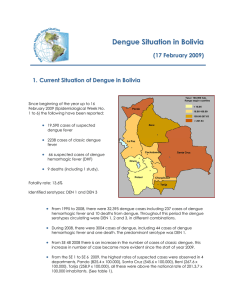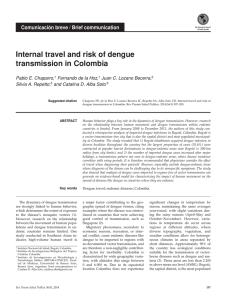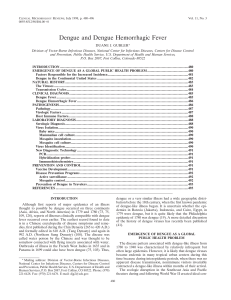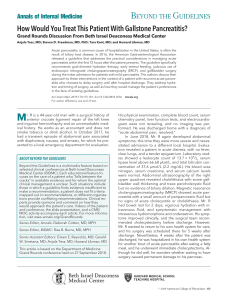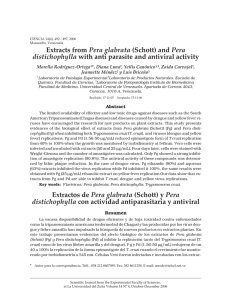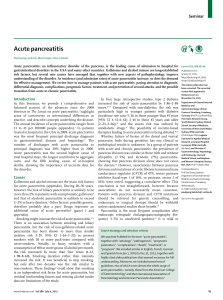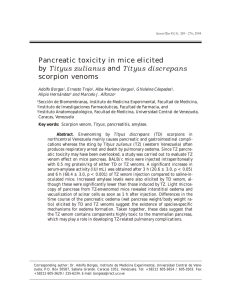Dengue hemorrhagic fever complicated by pancreatitis
Anuncio
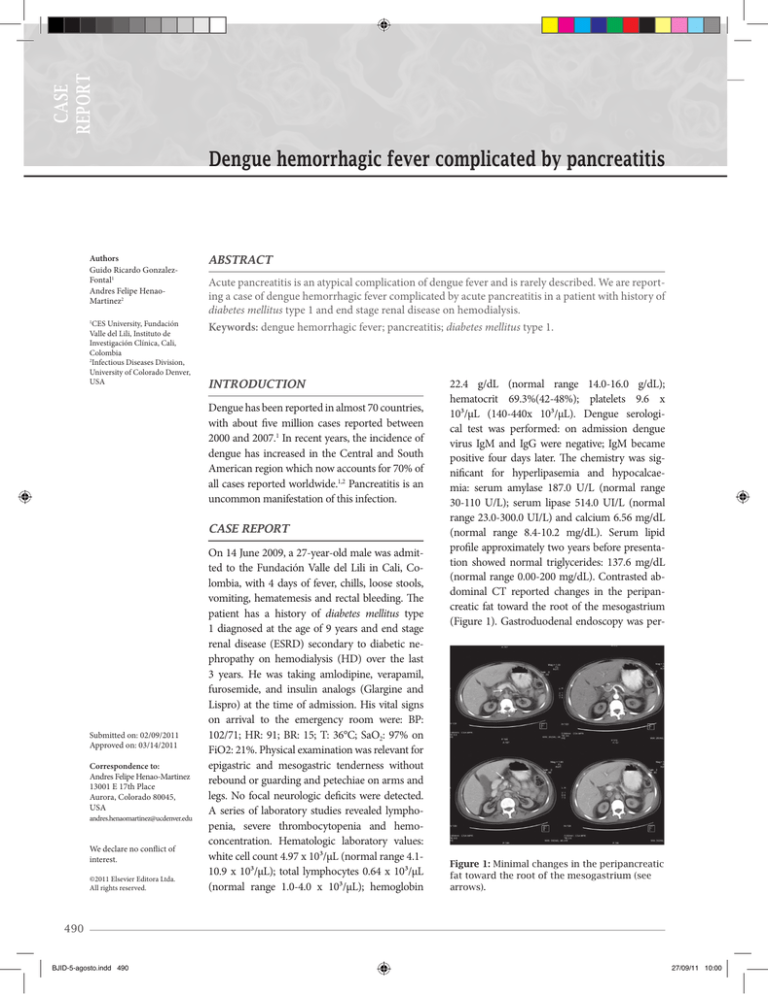
Case report Dengue hemorrhagic fever complicated by pancreatitis Authors Guido Ricardo GonzalezFontal1 Andres Felipe HenaoMartinez2 CES University, Fundación Valle del Lili, Instituto de Investigación Clínica, Cali, Colombia 2 Infectious Diseases Division, University of Colorado Denver, USA 1 ABSTRACT Acute pancreatitis is an atypical complication of dengue fever and is rarely described. We are reporting a case of dengue hemorrhagic fever complicated by acute pancreatitis in a patient with history of diabetes mellitus type 1 and end stage renal disease on hemodialysis. Keywords: dengue hemorrhagic fever; pancreatitis; diabetes mellitus type 1. INTRODUCTION Dengue has been reported in almost 70 countries, with about five million cases reported between 2000 and 2007.1 In recent years, the incidence of dengue has increased in the Central and South American region which now accounts for 70% of all cases reported worldwide.1,2 Pancreatitis is an uncommon manifestation of this infection. CASE REPORT Submitted on: 02/09/2011 Approved on: 03/14/2011 Correspondence to: Andres Felipe Henao-Martinez 13001 E 17th Place Aurora, Colorado 80045, USA [email protected] We declare no conflict of interest. ©2011 Elsevier Editora Ltda. All rights reserved. On 14 June 2009, a 27-year-old male was admitted to the Fundación Valle del Lili in Cali, Colombia, with 4 days of fever, chills, loose stools, vomiting, hematemesis and rectal bleeding. The patient has a history of diabetes mellitus type 1 diagnosed at the age of 9 years and end stage renal disease (ESRD) secondary to diabetic nephropathy on hemodialysis (HD) over the last 3 years. He was taking amlodipine, verapamil, furosemide, and insulin analogs (Glargine and Lispro) at the time of admission. His vital signs on arrival to the emergency room were: BP: 102/71; HR: 91; BR: 15; T: 36°C; SaO2: 97% on FiO2: 21%. Physical examination was relevant for epigastric and mesogastric tenderness without rebound or guarding and petechiae on arms and legs. No focal neurologic deficits were detected. A series of laboratory studies revealed lymphopenia, severe thrombocytopenia and hemoconcentration. Hematologic laboratory values: white cell count 4.97 x 10³/µL (normal range 4.110.9 x 10³/µL); total lymphocytes 0.64 x 10³/µL (normal range 1.0-4.0 x 10³/µL); hemoglobin 22.4 g/dL (normal range 14.0-16.0 g/dL); hematocrit 69.3%(42-48%); platelets 9.6 x 10³/µL (140-440x 10³/µL). Dengue serological test was performed: on admission dengue virus IgM and IgG were negative; IgM became positive four days later. The chemistry was significant for hyperlipasemia and hypocalcaemia: serum amylase 187.0 U/L (normal range 30-110 U/L); serum lipase 514.0 UI/L (normal range 23.0-300.0 UI/L) and calcium 6.56 mg/dL (normal range 8.4-10.2 mg/dL). Serum lipid profile approximately two years before presentation showed normal triglycerides: 137.6 mg/dL (normal range 0.00-200 mg/dL). Contrasted abdominal CT reported changes in the peripancreatic fat toward the root of the mesogastrium (Figure 1). Gastroduodenal endoscopy was per- Figure 1: Minimal changes in the peripancreatic fat toward the root of the mesogastrium (see arrows). 490 BJID-5-agosto.indd 490 27/09/11 10:00 Gonzalez-Fontal, Henao-Martinez formed finding hemorrhagic thrombocytopenic pangastropathy. The patient developed disseminated intravascular coagulation (DIC), was transferred to the intensive care unit where intravenous hydration and transfusion with platelet units, fresh frozen plasma and cryoprecipitate were given. The patient recovered slowly over the next days and was finally discharged at his 13th day of hospitalization with significant improvement in his clinical condition. DISCUSSION The dengue virus, a single stranded RNA virus belonging to the Flaviviridae family, has been classified into four serotypes, DENV-1, DENV-2, DENV-3, and DENV4, which are genetically and antigenically different.3 The main vector of the dengue virus is the mosquito Aedes aegypti. Dengue is classified as dengue fever, dengue hemorrhagic fever (DHF) or dengue shock syndrome (DSS) depending on its severity and presenting features. Our patient met the WHO criteria for a case definition of DHF.4 Pancreatitis was evident through marked increase in serum lipase and CT inflammatory findings.5 Although hyperlipasemia and pancreatic enlargement have been reported in acute dengue infection; pancreatitis as a DHF complication is considered an atypical manifestation.6 The largest described series was in an DHF outbreak in Taiwan in 2002 were pancreatitis (defined by a lipase level 3-fold greater than the upper limit of normal) was diagnosed in three patients with acute DHF,7 other five isolated cases have been described in Thailand, Indonesia, Noumea (New Caledonia) and Colombia (Table 1).8-12 Among all the cases it was noted that at least two more had history of diabetes as well. It is possible that diabetes itself was an aggravating condition that might have predisposed those patients to develop pancreatitis. The exact mechanism by which dengue virus induces acute pancreatitis is unclear and might be multifactorial. Based on data from patients with other types of viral pancreati- tis, several hypotheses for a pathogenic mechanism have been proposed. Among them are viral-associated acute pancreatitis due to direct inflammation and destruction of pancreatic acinar cells by the virus; acute viral infection acting as a trigger for an autoimmune response to pancreatic islet cells, which is induced by the similarity between viral and islet cells antigens, and the development of edema of the ampulla of Vater with obstruction to the outflow of pancreatic fluid.13-15 ACKNOWLEDGEMENTS To Dr. Mauricio Mejia from the Department of Radiology, Fundación Valle del Lili, for his collaboration with the CT scan interpretation and to Dr. Jose Cadena for his valuable help in the review of this manuscript. REFERENCES 1. World Health Organization. Dengue net. Available at: http:// apps.who.int/globalatlas/default.asp. Accessed Jan 6, 2010. 2. World Health Organization. Impact of dengue. Available at: www.who.int/csr/disease/dengue/impact/en/index.html. Accessed Jan 6, 2010. 3. Beasley DW, Barrett ADT. The infectious agent. Halstead SB Dengue: tropical medicine. Sixth edition. Imperial College Press 2008. Vol 5:29-73. 4. World Health Organization. Dengue haemorrhagic fever: diagnosis, treatment, prevention and control. 2nd ed. Geneva, WHO. 1997. 5. Ranson JH. Diagnostic standards for acute pancreatitis. World J Surg 1997; 21:136-42. 6. Gulati S, Maheshwari A. Atypical manifestations of dengue. Trop med and Inter Health 2007; 12:1087-95. 7. Lee I, Khor B, Kee K et al. Hyperlipasemia/pancreatitis in adults with dengue hemorrhagic fever. Pancreas 2007; 35(4):381-2. 8. Chen TC, Perng DS, Tsai JJ et al. Dengue hemorrhagic fever complicated with pancreatitis and seizure. J Formosan Med Assoc 2004; 103:865-8. 9. Derycke T, Levy P, Genelle B et al. Acute pancreatitis secondary to dengue. Gastroenterol Clin Biol 2005; 29:85-6. Table 1. Cases reported of dengue complicated with pancreatitis Cases Age/sex Country Associated findings Year Reference 1 10/F Thailand Liver failure 1988 [10] 2 < 13Y Colombia None 1992-2002 [12] 3 24/M Indonesia Unknown 1998[11] Diabetes mellitus 2002[7] 4-6N/A Taiwan 766/F Taiwan Seizures, diabetes mellitus2004 [8] 8 29/F Noumea (New Caledonia) 927/M Colombia Braz J Infect Dis 2011; 15(5):490-492 BJID-5-agosto.indd 491 None described 2005 [9] DIC, diabetes mellitus 2009Ours 491 27/09/11 12:56 Dengue complicated by pancreatitis 10. Jirapinyo P, Treetrakarn A, Vajaradul C et al. Dengue hemorrhagic fever: a case report with acute hepatic failure, protracted hypocalcemia, hyperamylasemia and an enlargement of the pancreas. J Med Assoc Thai 1988; 71:528-32. 11. Jusuf H, Sudjana P, Djumhana A et al. DHF with complication of acute pancreatitis related hyperglycemia: a case report. Southeast Asian J Trop Med Public Health 1998; 29:367-9. 12. Mendez A, Gonzalez G. Abnormal clinical manifestations of dengue hemorrhagic fever in children. Biomedica 2006; 26:61-70. 13. Shimoda T, Shikata T, Karasawa T et al. Light microscopic localization of hepatitis B virus antigens in the human pancreas. Gastroenterology 1981; 81:998-1005. 14. Oldstone MBA. Molecular mimicry and autoimmune disease. Cell 1987; 50:819-20. 15. Tsui CH, Burch GE, Harb JM. Pancreatitis in mice infected with Coxsackie virus B1. Arch Pathol 1972; 93:379-89. 492 BJID-5-agosto.indd 492 27/09/11 10:00
